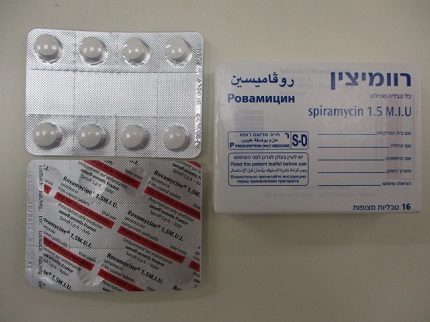Quest for the right Drug

רוומיצין ROVAMYCIN (SPIRAMYCIN)
תרופה במרשם
תרופה בסל
נרקוטיקה
ציטוטוקסיקה
צורת מתן:
פומי : PER OS
צורת מינון:
טבליות מצופות פילם : FILM COATED TABLETS
עלון לרופא
מינוניםPosology התוויות
Indications תופעות לוואי
Adverse reactions התוויות נגד
Contraindications אינטראקציות
Interactions מינון יתר
Overdose הריון/הנקה
Pregnancy & Lactation אוכלוסיות מיוחדות
Special populations תכונות פרמקולוגיות
Pharmacological properties מידע רוקחי
Pharmaceutical particulars אזהרת שימוש
Special Warning עלון לרופא
Physicians Leaflet
Special Warning : אזהרת שימוש
4.4. Special warnings and precautions for use Cases of severe skin reactions including Stevens-Johnson syndrome, toxic epidermal necrolysis, and acute generalised exanthematous pustulosis (AGEP) have been reported with Rovamycine. Patients must be informed of the signs and symptoms of these conditions and the skin should be closely monitored. If any signs or symptoms of Stevens-Johnson syndrome, toxic epidermal necrolysis (e.g. progressive skin eruption often with blisters or mucosal lesions) or AGEP (generalised febrile erythema associated with pustules) (see section 4.8) occur, treatment must be discontinued and any further administration of spiramycin alone or in combination with other agents is contraindicated. As the active substance is not eliminated via the renal route, there is no need to adjust the dose in patients with kidney failure. Very rare cases of haemolytic anaemia have been reported in patients with glucose-6- phosphate-dehydrogenase deficiency. Use of spiramycin in these patients is therefore not recommended. Prolongation of the QT interval Cases of prolonged QT interval have been reported in patients taking macrolides, including spiramycin. Caution should be exercised when using spiramycin, in patients with known risk factors for prolongation of the QT interval such as: - uncorrected electrolyte imbalance (e.g. hypokalaemia, hypomagnesaemia), - congenital long QT syndrome, - cardiac disease (e.g. heart failure, myocardial infarction, bradycardia). - concomitant use of medicinal products that are known to prolong the QT interval (e.g. class IA and III antiarrhythmics, tricyclic antidepressants, some antibiotics, some antipsychotics, hydroxychloroquine and chloroquine), - elderly subjects, neonates and women may be more susceptible to QT prolongation. (See sections 4.2, 4.5, 4.8 and 4.9) This medicinal product contains less than 1 mmol (23 mg) sodium per tablet, that is to say essentially ‘sodium-free’.
Effects on Driving

שימוש לפי פנקס קופ''ח כללית 1994
לא צוין
תאריך הכללה מקורי בסל
לא צוין
הגבלות
לא צוין
מידע נוסף
עלון מידע לצרכן
11.10.20 - עלון לצרכן אנגלית 14.03.22 - עלון לצרכן עברית 11.10.20 - עלון לצרכן ערבית 12.10.22 - עלון לצרכן אנגלית 12.10.22 - עלון לצרכן עברית 12.10.22 - עלון לצרכן ערבית 11.01.24 - עלון לצרכן עברית 26.08.15 - החמרה לעלון 25.05.20 - החמרה לעלון 14.03.22 - החמרה לעלון 08.02.24 - החמרה לעלוןלתרופה במאגר משרד הבריאות
רוומיצין